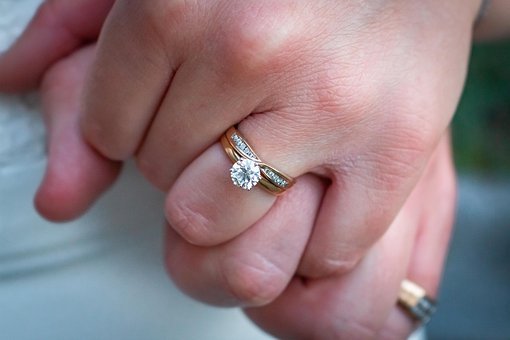A marriage is a once-in-a-lifetime event, and the jewelry that comes with it celebrates this special bond. Two of the most meaningful pieces of jewelry worn by couples are the engagement ring and wedding band. They symbolize the commitment and love you share with your partner and represent a lifetime of memories. Not only do they signify love and devotion, but these accessories can also be seen as expressions of individual style.
What Are Engagement Rings and Wedding Bands?
Engagement Rings are given as a symbol of a couple’s commitment to each other. They are traditionally given by a man to a woman when he proposes marriage. Engagement rings are typically made with a precious metal such as gold, silver, or platinum and feature a diamond or other precious gemstone as the centerpiece.
The diamond is often chosen for its durability and timeless beauty. It symbolizes the strength and longevity of the couple’s love for each other. Other gemstones can be used as well, such as sapphires, rubies, or emeralds, depending on personal preference.
When choosing an engagement ring, it is important to consider the four Cs of diamond quality: cut, color, clarity, and carat weight. The cut refers to the diamond’s angles and proportions, which affect its brilliance and sparkle. The color refers to the degree of colorlessness or tint in the diamond. The clarity refers to the presence of internal and external flaws. The carat weight refers to the size of the diamond.
Wedding Bands hold an essential place in a couple’s life. It is the ultimate symbol of a couple’s love and commitment to each other. Wedding bands are exchanged during the wedding ceremony, and it represents the union between two people. It is a promise to love, cherish, and support each other through thick and thin.
Wedding bands hold a special place in a couple’s life because they are worn every day. Unlike engagement rings, wedding bands are simple and more practical. They symbolize a couple’s dedication and commitment to each other and serve as a constant reminder of their love.
The Evolution of Engagement Rings and Wedding Bands
The tradition of engagement rings and wedding bands dates back to ancient times. In Ancient Egypt, rings were considered symbols of eternity, and they were exchanged as a promise of everlasting love. The Romans also had a tradition of giving engagement rings, which were seen as a sign of ownership of the woman.
During the Renaissance period, engagement rings became more intricate and ornate. Diamonds were first used in engagement rings in the 15th century, and they became popular among the aristocracy during the 16th and 17th centuries. However, it wasn’t until the 19th century that diamonds became widely used in engagement rings. This was due to a marketing campaign by diamond company De Beers, which promoted the idea that “a diamond is forever.”
Wedding bands, on the other hand, have been exchanged for centuries as a symbol of commitment and fidelity. The first recorded instance of a wedding band being exchanged during a ceremony dates back to Ancient Egypt. In Christian weddings, the ring is often worn on the fourth finger of the left hand, as it was believed that this finger had a vein that led directly to the heart.
Over time, wedding bands have evolved to become more personalized and unique. Today, there are many different styles of wedding bands, from classic plain bands to bands featuring diamonds or other gemstones. Some couples choose to have their wedding bands engraved with their initials or a special message.
Overall, the tradition of engagement rings and wedding bands has evolved over time to become a symbol of love, commitment, and unity between two people.
Types of Engagement Rings
Engagement rings come in many different styles, and choosing the perfect one can be a daunting task. Here are some of the most popular types of engagement rings:
Solitaire: A solitaire engagement ring features a single diamond or gemstone set in a simple metal band. This classic style is timeless and elegant.

Halo: A halo engagement ring features a center stone surrounded by a circle of smaller diamonds or gemstones. This style adds extra sparkle and can make the center stone appear larger.

Three-stone: A three-stone engagement ring features a center stone flanked by two smaller stones. This style represents the past, present, and future of the relationship.

Two Stone: a two stone ring features two center stones that are typically of the same size and shape. These stones can represent a couple’s bond and commitment to each other.

Vintage: Vintage engagement rings are inspired by styles from past eras, such as the Art Deco or Victorian periods. They often feature intricate details and unique designs.

Colored stones: Instead of a traditional diamond, some engagement rings feature colored gemstones as the center stone. Popular choices include sapphires, emeralds, and rubies.

Pave: A pave engagement ring features small diamonds set closely together along the band, creating a sparkling, textured look.
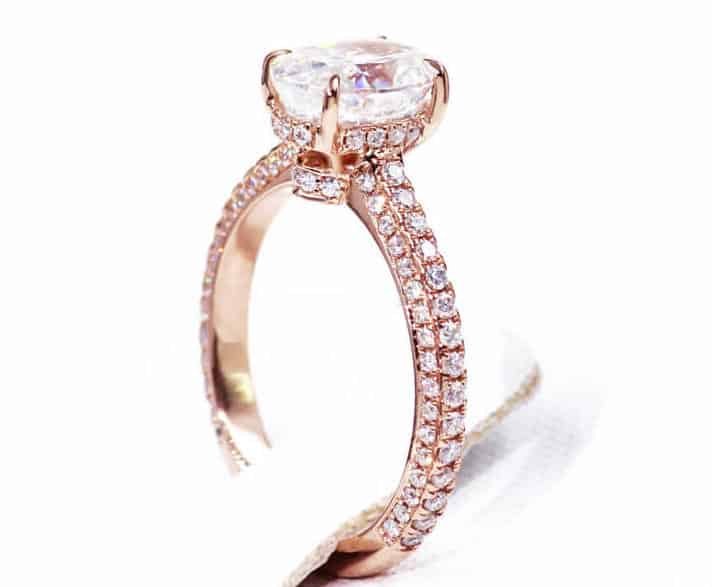
Tension: A tension engagement ring uses pressure to hold the center stone in place, creating a modern and minimalist look.

Cluster: A cluster engagement ring features multiple smaller diamonds or gemstones arranged together to create the appearance of a larger stone.
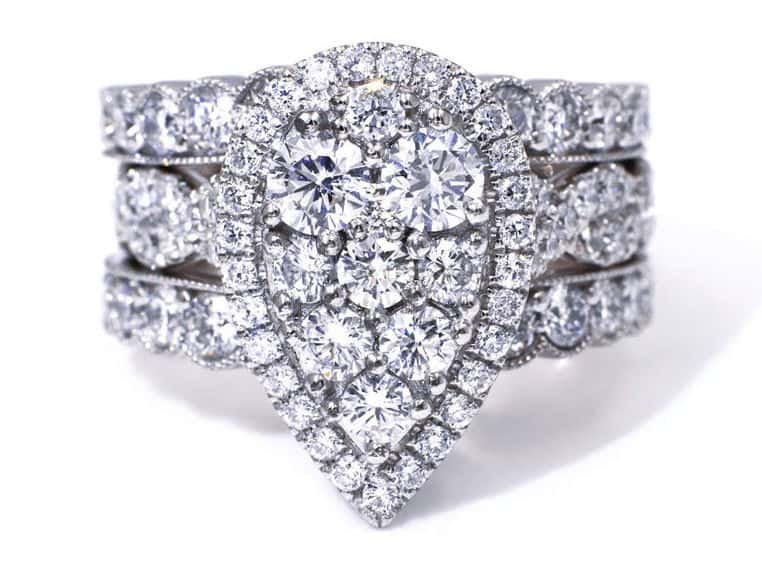
Split shank: A split shank engagement ring features a band that splits into two as it approaches the center stone, creating a unique and eye-catching design.
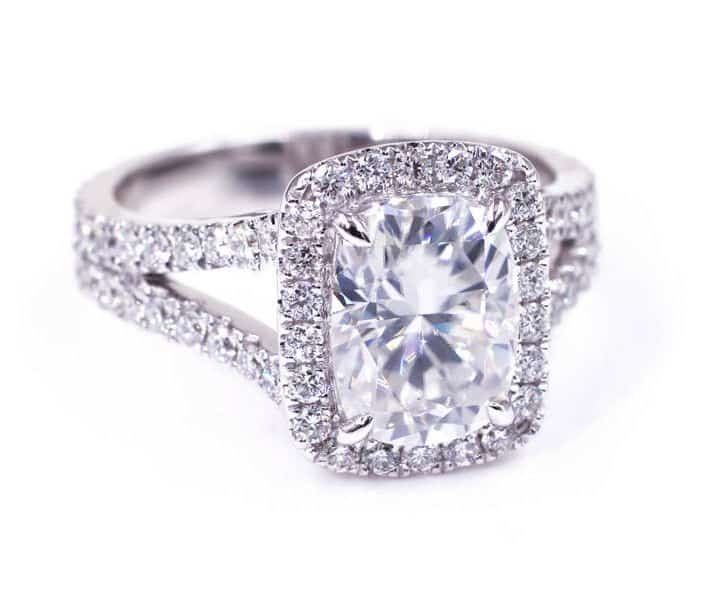
Overall, the style of engagement ring you choose should reflect your personal taste and individuality, as well as your budget and lifestyle.
Choosing the right engagement ring
Choosing the right engagement ring is an important decision and can feel overwhelming. Here are some tips to help you find the perfect ring:
Set a budget: Engagement rings come in a wide range of prices, so it’s important to set a budget before you start shopping. This will help you narrow down your options and prevent overspending.
Consider your partner’s style: Take into consideration your partner’s personal style when choosing an engagement ring. Do they prefer classic or modern styles? Do they like a lot of sparkle or prefer a simpler look?
Look at ring size and shape: The shape and size of the ring can make a big difference in how it looks on your partner’s hand. Take note of their finger size and shape when trying on rings to find the perfect fit.
Think about the metal: Engagement rings come in a variety of metals, such as white gold, yellow gold, rose gold, and platinum. Consider your partner’s preference and skin tone when choosing a metal.
Choose the right diamond: If you’re choosing a diamond engagement ring, consider the “4 Cs” – carat weight, cut, color, and clarity. These factors will affect the overall look and price of the diamond.
Consider a custom design: If you’re not finding the perfect ring, consider working with a jeweler to create a custom design. This allows you to create a one-of-a-kind ring that reflects your partner’s unique style.
Shop around: Don’t be afraid to visit multiple jewelers and try on different styles of rings. This will help you get a better sense of what you like and what looks best on your partner.
Remember, the most important thing is that the engagement ring is a symbol of your love and commitment to each other. The perfect ring is one that your partner will love and cherish for years to come.
Types of wedding bands
Wedding bands come in a variety of styles and designs to suit different preferences and budgets. Here are some of the most popular types of wedding bands:
Classic: A classic wedding band is a timeless choice that features a simple metal band, usually made of gold or platinum. This style is versatile and can complement any engagement ring.
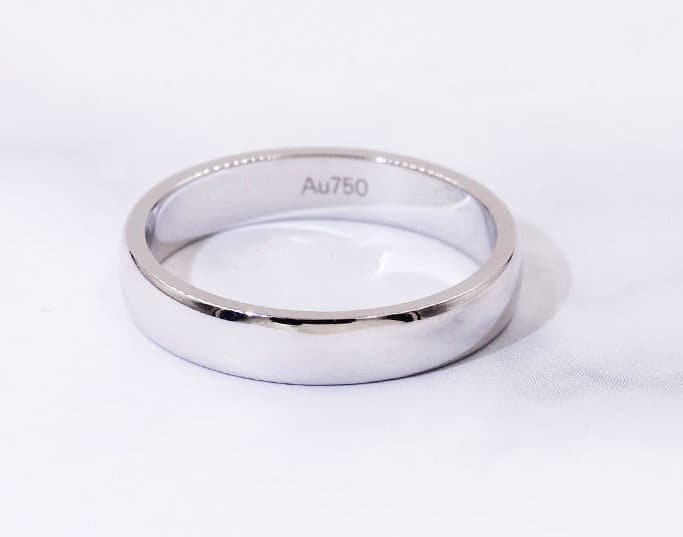
Eternity: An eternity wedding band features diamonds or gemstones set around the entire band, symbolizing eternal love. This style adds extra sparkle and can be worn alone or paired with an engagement ring.

Contoured: A contoured wedding band is designed to fit perfectly with an engagement ring, often featuring a curved or notched shape that sits snugly against the engagement ring.
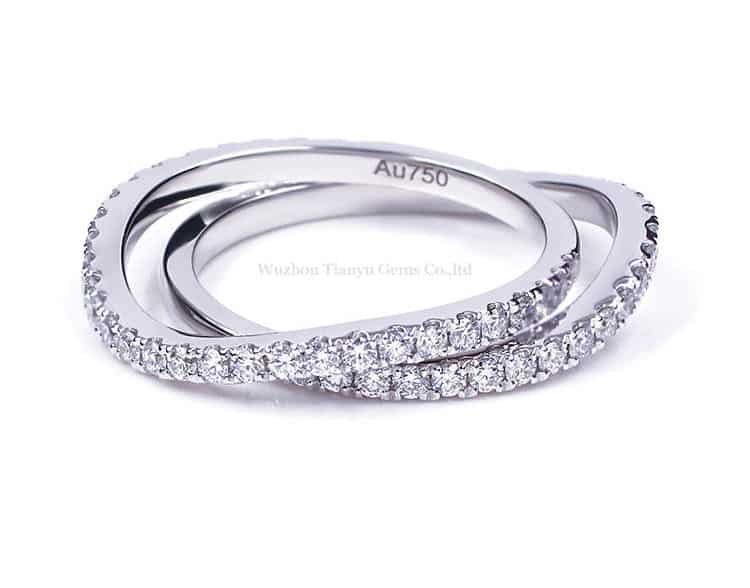
Diamond: A diamond wedding band features one or more diamonds set into the band, creating a subtle yet sparkling look. This style can be worn alone or paired with an engagement ring.
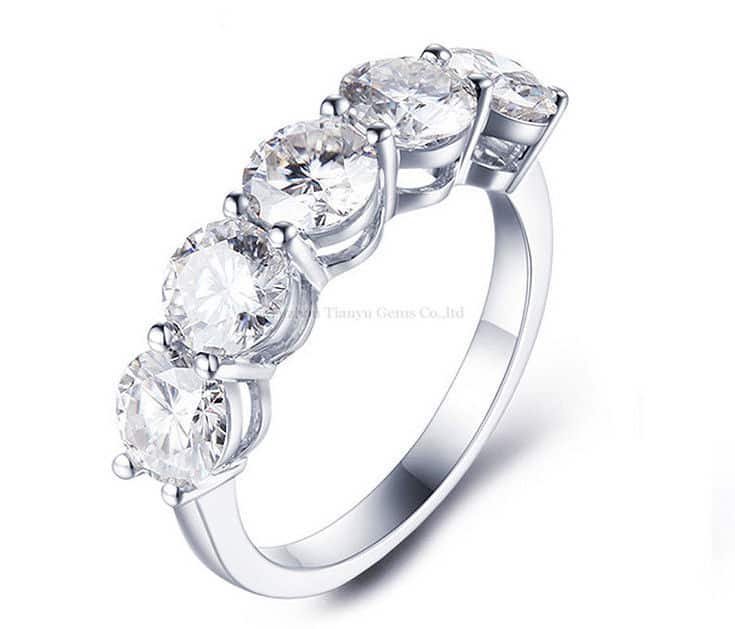
Vintage: Vintage wedding bands are inspired by styles from past eras, such as the Art Deco or Victorian periods. They often feature intricate details and unique designs.
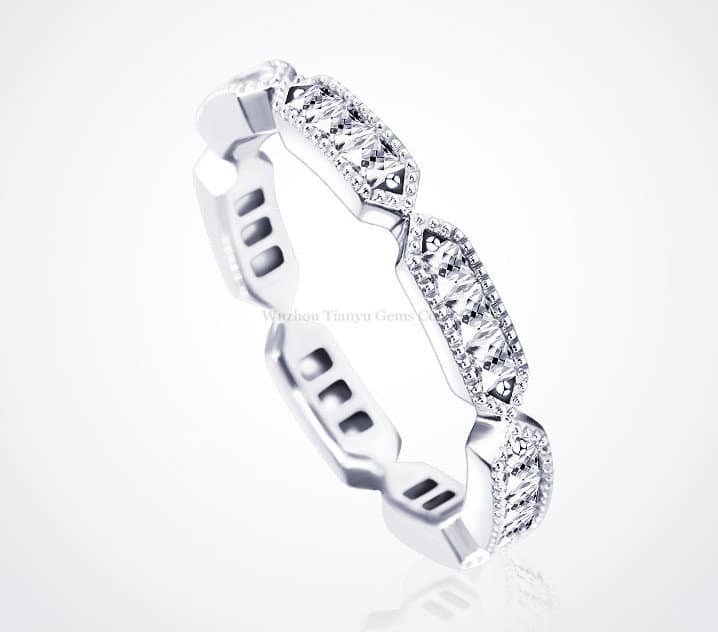
Two-tone: A two-tone wedding band features two different metals, such as gold and platinum, creating a unique and modern look.
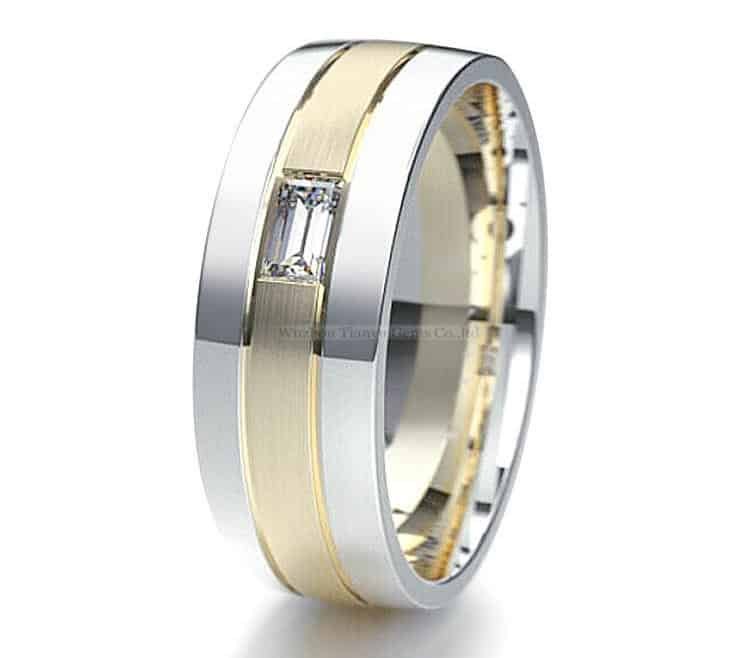
Personalized: Personalized wedding bands can be engraved with a special message, initials, or a date, making them a meaningful and sentimental choice.
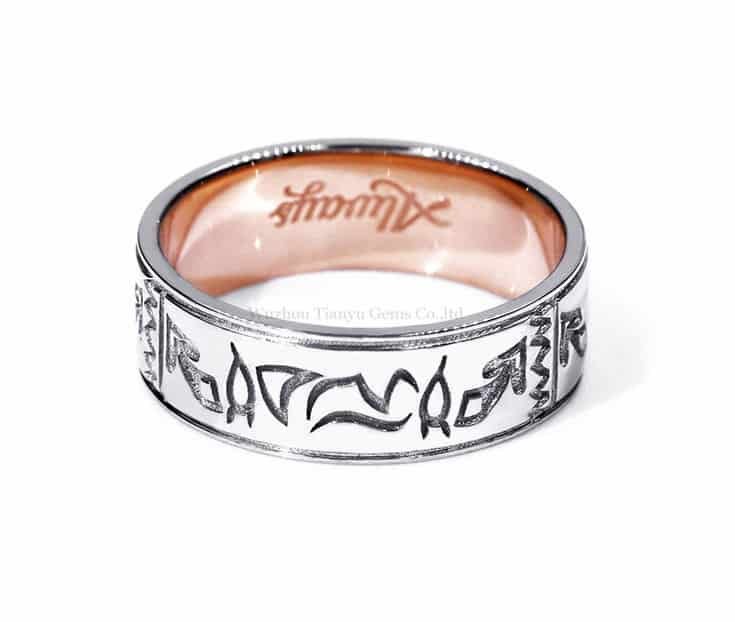
When choosing a wedding band, consider the metal, style, and how it will pair with your engagement ring. It’s important to choose a wedding band that not only looks great but also feels comfortable to wear every day.
Choosing the right wedding band
Choosing the right wedding band is an important decision that will be worn for a lifetime. Here are some tips to help you find the perfect wedding band:
Consider the metal: Wedding bands come in a variety of metals, including gold, platinum, and titanium. Consider the metal that complements your engagement ring and matches your personal style.
Decide on the width: The width of a wedding band can range from very narrow to wide. Consider the width that looks best on your finger and complements your engagement ring.
Look at the design: Wedding bands come in a range of designs, including classic, diamond-studded, and engraved. Consider the design that reflects your personality and style.
Try on different styles: It’s important to try on different styles and widths of wedding bands to find the one that feels most comfortable and looks best on your hand.
Consider the durability: If you lead an active lifestyle, consider a wedding band made of a durable metal like platinum or titanium that can withstand daily wear and tear.
Choose a timeless style: Wedding bands are meant to be worn for a lifetime, so it’s important to choose a timeless style that will never go out of fashion.
Coordinate with your partner: If you and your partner plan to have matching wedding bands, coordinate the style, metal, and design to create a cohesive look.
Remember, your wedding band is a symbol of your love and commitment to your partner. The perfect wedding band is one that reflects your personal style, feels comfortable to wear, and will last a lifetime.
How To Shop Your Engagement Rings and Wedding Bands
Shopping for engagement rings and wedding bands can be a fun and exciting experience, but it can also be overwhelming with so many options available. Here are some tips to help you navigate the shopping process:
In-person shopping
In-person shopping for engagement rings and wedding bands can be a great way to see and try on pieces in person. Here are some tips for making the most of your in-person shopping experience:
Make an appointment: Many jewelry stores require appointments for engagement ring and wedding band consultations. Be sure to call ahead and schedule a time that works for you and the jeweler.
Bring inspiration: If you have a specific style or design in mind, bring inspiration photos or sketches with you to the appointment. This can help the jeweler understand your vision and suggest pieces that meet your preferences.
Ask questions: Don’t be afraid to ask the jeweler questions about the metals, stones, and craftsmanship of the engagement ring or wedding band. This can help you make an informed decision and ensure you’re getting a high-quality piece.
Try on different styles: Trying on different styles of engagement rings and wedding bands can help you get a feel for what looks best on your finger and complements your personal style.
Consider customizing: Many jewelers offer customization options for engagement rings and wedding bands, allowing you to create a unique piece that reflects your personal style and preferences.
Take your time: Choosing an engagement ring or wedding band is a personal decision that shouldn’t be rushed. Take your time during the appointment to ensure you find the perfect piece for you and your partner.
Check warranties and returns policies: Before making a purchase, be sure to check the warranties and returns policies of the jewelry store. This can provide peace of mind and ensure you’re satisfied with your purchase.
In-person shopping for engagement rings and wedding bands can be an exciting and rewarding experience. By following these tips, you can make the most of your appointment and find the perfect pieces to symbolize your love and commitment.
Online shopping
Online shopping for engagement rings and wedding bands has become increasingly popular in recent years. Here are some tips to help you navigate the online shopping process:
Choose a reputable online retailer: When shopping for engagement rings or wedding bands online, it’s important to choose a reputable retailer that offers high-quality pieces and excellent customer service.
Read reviews: Before making a purchase, read customer reviews of the retailer and the specific piece you’re interested in. This can help you gauge the quality of the product and the customer service provided by the retailer.
Know your ring size: It’s important to know your ring size before making an online purchase. Most online retailers provide a ring sizing chart that you can use to determine your size.
Research the 4Cs: If you’re purchasing a diamond engagement ring online, research the 4Cs (carat weight, cut, color, and clarity) to ensure you’re getting a high-quality stone.
Look for certification: If you’re purchasing a diamond engagement ring, look for certification from a reputable organization like the Gemological Institute of America (GIA) or the American Gem Society (AGS).
Compare prices: One of the benefits of shopping online is the ability to compare prices across multiple retailers. Be sure to compare prices and features to ensure you’re getting the best value for your money.
Check the return policy: Before making a purchase, check the retailer’s return policy to ensure you’re satisfied with the terms and conditions.
Remember, online shopping for engagement rings and wedding bands can be a convenient and affordable option. By following these tips, you can make an informed decision and find the perfect pieces to symbolize your love and commitment.
Advantages And Disadvantages Of Each
When it comes to shopping for engagement rings and wedding bands, both in-person and online shopping have their advantages and disadvantages. Here are some to consider:
Advantages of In-Person Shopping:
The ability to see and try on the rings in person: When shopping in person, you can see the rings up close and try them on to get a better idea of how they look and feel.
Immediate feedback: You can get immediate feedback from a salesperson or jeweler who can answer your questions and offer advice.
Customization options: In-person shopping often offers more customization options, allowing you to create a unique piece that perfectly reflects your style and preferences.
Personalized service: In-person shopping often offers personalized service, allowing you to build a relationship with the jeweler or salesperson who can help guide you through the process.
Disadvantages of In-Person Shopping:
Limited selection: Depending on where you shop, the selection of engagement rings and wedding bands may be limited.
Higher prices: In-person shopping often comes with higher prices due to overhead costs.
Time-consuming: Shopping in person can be time-consuming, requiring you to visit multiple stores to find the perfect ring.
Advantages of Online Shopping:
Wide selection: Online shopping offers a wide selection of engagement rings and wedding bands, allowing you to browse a variety of styles and prices.
Convenience: Online shopping can be done from the comfort of your own home, eliminating the need to travel to multiple stores.
Lower prices: Online retailers often offer lower prices due to lower overhead costs.
Comparison shopping: Online shopping allows you to easily compare prices and features across multiple retailers.
Disadvantages of Online Shopping:
Unable to see or try on the rings in person: The biggest disadvantage of online shopping is the inability to see or try on the rings before making a purchase.
Limited customization options: Online retailers may offer limited customization options compared to in-person shopping.
Quality concerns: It can be difficult to determine the quality of the rings when shopping online, so it’s important to read reviews and purchase from reputable retailers.
Ultimately, the decision between in-person and online shopping for engagement rings and wedding bands depends on your personal preferences and priorities. By considering the advantages and disadvantages of each, you can make an informed decision and find the perfect rings to symbolize your love and commitment.
Regular Cleaning And Maintenance
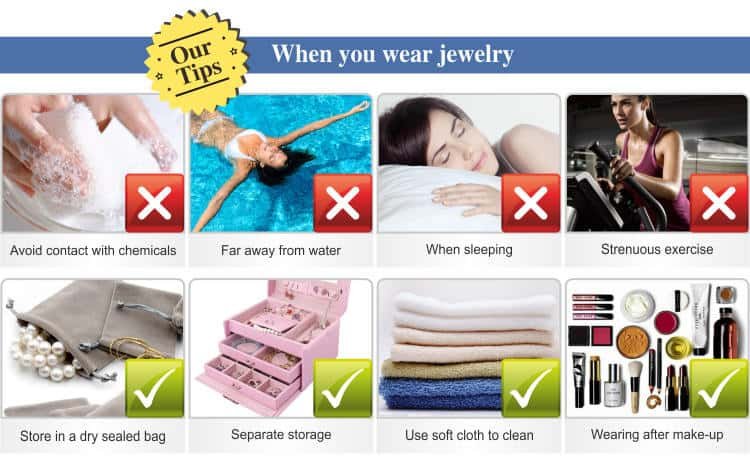
Engagement rings and wedding bands are often worn every day, which means they can become dirty and dull over time. To keep your rings looking their best, regular cleaning and maintenance is essential. Here are some tips for keeping your rings in top condition:
Clean your rings regularly: To remove dirt and grime from your rings, use a soft-bristled toothbrush and mild dish soap to gently scrub the rings. Rinse them thoroughly with warm water and dry them with a soft, lint-free cloth.
Avoid exposing your rings to harsh chemicals: Chemicals such as chlorine and bleach can damage the metal and gemstones in your rings, so it’s important to avoid exposing them to these substances.
Store your rings properly: When you’re not wearing your rings, store them in a soft pouch or jewelry box to protect them from scratches and damage.
Get your rings inspected by a professional: A jeweler can inspect your rings to ensure that the prongs holding the gemstones are secure and that there are no other issues that could cause damage or loss of the stones.
Have your rings professionally cleaned: It’s a good idea to have your rings professionally cleaned and polished by a jeweler every year or so to keep them looking their best.
By following these tips, you can keep your engagement ring and wedding band looking beautiful and in great condition for years to come. Remember that regular maintenance is key to preserving the beauty and value of your rings, so make it a part of your routine to keep them in top shape.
Insurance And Warranty
When purchasing engagement rings and wedding bands, it’s important to consider insurance and warranty options to protect your investment. Here’s what you need to know:
Insurance: Insuring your rings can provide financial protection in case of loss, theft, or damage. Many insurance companies offer specialized jewelry insurance policies that cover a range of scenarios, such as loss or damage while traveling, accidental damage, or theft. The cost of insurance can vary depending on the value of your rings and the coverage you choose. It’s important to read the fine print carefully and understand what is and isn’t covered.
Warranty: Many jewelers offer warranties on their engagement rings and wedding bands, which typically cover manufacturing defects or damage that occurs under normal wear and tear. The length and coverage of the warranty can vary, so it’s important to ask about the specifics before making a purchase. It’s also a good idea to read reviews and check the reputation of the jeweler to ensure that they honor their warranties.
Additional considerations: When considering insurance and warranty options, be sure to ask about any deductibles, limits, or exclusions. Some policies may not cover loss or damage caused by certain activities, such as swimming or extreme sports. Additionally, it’s important to keep detailed records of your purchase, including receipts and appraisals, to help with the claims process in case of loss or damage.
In summary, insurance and warranty options can provide peace of mind and financial protection for your engagement ring and wedding band. It’s important to understand the coverage options, read the fine print, and keep detailed records of your purchase. By doing so, you can protect your investment and enjoy your rings with confidence.
How To Handle Damage Or Loss
Damage or loss of an engagement ring or wedding band can be a stressful and emotional experience. Here are the steps to take if you find yourself in this situation:
Contact your insurance provider or jeweler’s warranty department: If you have insurance or a warranty on your ring, contact your provider or jeweler’s warranty department as soon as possible to report the damage or loss. They will guide you through the claims process and provide instructions on next steps.
File a police report: If your ring was lost or stolen, it’s important to file a police report as soon as possible. This will help in the event that the ring is recovered and can also be required by your insurance provider.
Get a professional appraisal: If your ring was damaged or lost, getting a professional appraisal can help establish the value of the ring for insurance or warranty purposes.
Consider repair or replacement options: Depending on the extent of the damage or loss, repair or replacement options may be available. Your insurance provider or jeweler’s warranty department can provide guidance on these options.
Take steps to prevent future damage or loss: Once your claim has been settled, take steps to prevent future damage or loss of your ring. This may include getting it regularly cleaned and inspected by a jeweler, wearing it only during appropriate activities, or keeping it in a secure location when not being worn.
In summary, if your engagement ring or wedding band is damaged or lost, it’s important to take quick action by contacting your insurance provider or jeweler’s warranty department, filing a police report, getting a professional appraisal, and considering repair or replacement options. By taking these steps and preventing future damage or loss, you can enjoy your ring for years to come.
The Tradition Of Engagement Rings And Wedding Bands
The tradition of exchanging engagement rings and wedding bands dates back centuries and is deeply rooted in cultures around the world. Here is a brief history of this beloved tradition:
The tradition of engagement rings dates back to ancient Rome, where it was customary for the groom to give his bride-to-be a ring made of iron to symbolize legal ownership. The iron ring eventually gave way to gold and other precious metals, which were seen as a symbol of the groom’s wealth and status.
The tradition of the diamond engagement ring specifically is attributed to the De Beers diamond company in the 1940s. Through clever marketing campaigns, they convinced the public that a diamond engagement ring was a necessary symbol of love and commitment.
Wedding bands, on the other hand, have been a part of many cultures for centuries. The ancient Egyptians believed that the circular shape of a wedding band represented eternity, and the Romans exchanged simple iron bands during their wedding ceremonies.
Today, the tradition of exchanging engagement rings and wedding bands is deeply ingrained in many cultures around the world. The engagement ring symbolizes the promise of marriage and is often worn on the ring finger of the left hand, while the wedding band represents the couple’s union and is typically worn on the same finger, either above or below the engagement ring.
While the tradition of engagement rings and wedding bands has evolved over time, the sentiment behind these symbols of love and commitment remains the same. Whether it’s a diamond engagement ring or a simple gold wedding band, these symbols represent the promise of forever and serve as a reminder of the love and commitment shared between two people.
Final thoughts and recommendations
In conclusion, engagement rings and wedding bands are timeless symbols of love and commitment that hold great importance for couples around the world. With so many options available, it can be overwhelming to choose the right ring for you and your partner.
We hope this professional guide has provided valuable information to help you make an informed decision when shopping for these special pieces of jewelry. Remember to consider factors such as style, metal type, gemstones, and symbolism when selecting your ring.
Additionally, it’s important to take good care of your rings through regular cleaning and maintenance, as well as investing in insurance and warranties to protect against loss or damage.
Ultimately, the most important factor in choosing an engagement ring or wedding band is that it feels right for you and your partner. Take your time, do your research, and trust your instincts to find the perfect ring that symbolizes your love and commitment.

